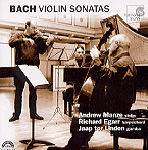What more do you say about a musician who’s already stormed and conquered the world of Baroque violin repertoire and performance? About to embark on his North American solo recital debut tour (see Classical World News section for details), Andrew Manze has proven that in an entertainment world filled with overhyped and overblown supertenors and overnight sensation child-exploitation singing acts, good, honest, virtuoso violin playing can be the most soul-satisfying, exciting, and pleasurable musical experience anywhere. We’ve heard him previously in Telemann, Tartini, Rebel, and Biber, and in the concertos of Bach, and now we’re treated to some of the most dynamic and sonically assertive recorded performances of Bach’s violin sonatas–the six “accompanied” works (BWV 1014-19), including two versions of the G major sonata, the two authentic “continuo” sonatas (BWV 1021 and 1023), plus one (BWV 1024) of more than doubtful origin. Rounding out the program is Manze’s own reconstruction for solo violin of another dubious but famous work long attributed to Bach: the Toccata and Fugue in D minor for organ BWV 565. Yes, Manze follows a tradition suggesting that this “greatest hit” originated as a violin piece and offers an absolutely amazing tour de force interpretation that’s worth a million Pavarotti “Nessun dorma” recordings or Charlotte Church videos. It’s also a pleasure to hear among these technically challenging sonatas some of Bach’s most engaging violin writing, including the unforgettably beautiful “Largo” of BWV 1017, which bears a striking resemblance to the beloved St. Matthew Passion aria “Erbarme dich, mein Gott”.
Manze’s 18th-century Joseph Gagliano violin displays both a brilliant upper register and sweetly seasoned low end, shown to fine effect in movements such as the “Affetuoso” of BWV 1024. Manze’s partners on keyboard, viola da gamba (used only in the first two sonatas), and cello (BWV 1023 and 1024) certainly are the violinist’s equal in interpretive vision, and in terms of energy and in the confident assertion of their respective parts. A word about the sound: The acoustic seems to be a very resonant space that takes kindly to the solo violin and violin with harpsichord. But in the busier, faster movements that include viola da gamba or cello, the clarity of lines becomes slightly smudged amid all the excitedly reverberating tones and overtones. This is partly a function of the writing, and it’s interesting to note that in the title of the six accompanied sonatas it suggests viola da gamba accompaniment “if you like”. Perhaps the harpsichord’s bass line would have been enough (especially this very lively and full-bodied harpsichord), but the gamba adds many effective textural and coloristic details without which some movements–particularly the slow movements of BWV 1014–wouldn’t be nearly so lovely.
































